Menus
- Japanese legend, successor to the GSX1100S Katana
- 4 cylinders in line, 999 cm3, 150 hp, 108 Nm, 215 kg full made, 13,699 euros
- Discovery
- In the saddle
- In the city
- Motorway and expressways
- Departmental
- Part-cycle
- Braking
- Comfort / Duo
- Consumption
- Conclusion
- Suzuki Katana video test
Japanese legend, successor to the GSX1100S Katana
4 cylinders in line, 999 cm3, 150 hp, 108 Nm, 215 kg full made, 13,699 euros
The Katana is a very old weapon, all the more ancient since we refer here to the famous samurai sword, thus going back in time to the Kamakura period (1185–1333). The Katana is also both a thrust weapon and a real symbol associated with the Japanese warrior. It could therefore only reappear in Japan, first in the 80s and then again in 2019. And since the Katana is Japanese, it was absolutely necessary to go to Japan to take it in hand. It is done with this test of the Suzuki Katana in the vicinity of Kyoto !
But a little history. At the end of the 1970s, to boost its range of GS750 and GSX750E, Suzuki asked the little-known German studio Target Design of Starnberg (near Munich), the design of a new machine. This will first give the GSX650G, which then relies on an ED-1 prototype. This will then give in 1981 the astonishing GSX1100S Katana, astonishing both for its futuristic design – even if it comes from the GSX1100E of the end of the 70s – and for its innovations like its fork with the anti-dive system linked to the brake. . The machine is then powered by a 1,074 cm3 in-line four-cylinder, air-cooled, developing 107 hp at 8,750 rpm and 89 Nm of torque at 6,500 rpm, with TSCC twin turbulence chambers, not to mention an imposing wheel of 19 inches at the front.
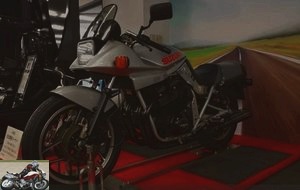 The original Suzuki Katana
The original Suzuki Katana
Several versions will follow in 1982 as an EM550 reserved for the European market and a GSX1000S dedicated to America. The GSX750S will be followed by a more sensational GSX750 S3 in 1984, with an airplane type front face and retractable light! 250 and 400 will even be produced between 1992 and 1994. But the flagship model will continue its marketing until 2001, ie 20 years of production! It was then voted the most important motorcycle of the last 30 years in Japan..
The surname Katana obviously evokes the famous Japanese sword whose design combines attention to detail, elegance, purity and excellence. With craftsmanship and tradition, Suzuki brings together industry and modernity, retaining these values to awaken the legend and realize its 2019 model. Like the original model, the novelty is a variation of the brand’s roadsters. To present its historic flagship, largely based on the GSX-S1000 and GSX-S1000F, the Hamamatsu brand invites us to its home. Between cherry trees, almost, in bloom and specialist in exceptional blades, beauty and typical Japanese performance, we take control of the new Katana. !
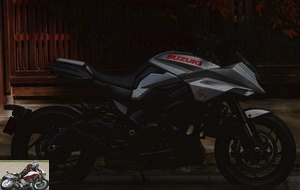 Suzuki Katana 2019 version review
Suzuki Katana 2019 version review
Discovery
Deliciously neo-retro 80s, the novelty is a subtle reinterpretation of the original concept. The design is superb, very Japanese although designed by the Italian designer Rodolfo Frascoli. All in fluidity and sportiness, it confers at the same time dynamism, power and elegance to the machine, also symbolic qualities of the Japanese sword..
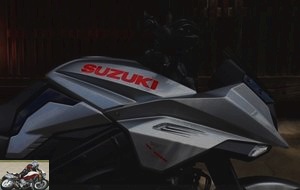 The fairing is inspired by the design of the original model
The fairing is inspired by the design of the original model
Main element of the style, a rectangular headlight entirely with LEDs, imitating the optics of the time. A short deflector covers this front light, which two angular half fairings surround. We note the integration of position lights in bevels. The casing forms short scoops and runs in taut lines and stylish flats towards the 12-liter tank. It’s not much, but controlled injection, according to Suzuki, should ensure consumption of 5.6 liters per 100 km, or 180 km before reserve. The manufacturer assumes this choice to stick as well as possible to the racy aesthetics of his model. Thus, Satoru Terada, chief engineer, affirms the importance of the style for this machine and its prevalence on the capacity. I also validate, you have to know how to bend to history and I like this franchise. In addition, the machine is clearly not intended for travel.
 The Katana’s tank offers a capacity of 12 liters
The Katana’s tank offers a capacity of 12 liters
A streamlined saddle rests on this ovoid container and covers a sheathed rear buckle, devoid of passenger handles. Angular, subtly faceted, the stern trim concludes with a sharp tail light whose light lugs form two commas, like red kanji. Stylish! The whole machine’s light signature is superb.
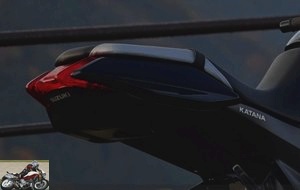 The back part of the Katana is very short
The back part of the Katana is very short
The general finish is appreciable, down to the details, where trim and components hardly suffer from their adjustment. The front fender bracket is solid metal, but the passenger footrest brackets admit an unflattering hollow internal face. Likewise, the surfaces of the frame and the swingarm deserve better than these too visible weld seams. Finally, the remote license plate holder is massive, not very elegant. The seat opening located under the wheel arch is very exposed to projections and deserves protection. Good point, the battery is very accessible under the saddle.
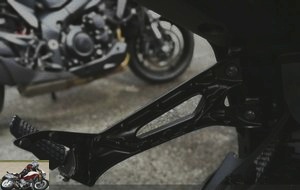 The rear of the passenger footrests is hardly graceful
The rear of the passenger footrests is hardly graceful
Cables and hoses are well integrated into the unit. Only the starter, prominent on the right side, will require the sides to be adorned with protective pads (see accessories). The more aesthetic will use the wide choice of carbon-based options and other customization accessories. I always enjoy the set of colored front calipers…. In red, of course, they must brake harder! Graphic kit and carbon parts will enhance the style of the machine.
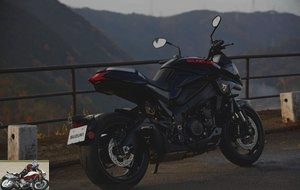 The Suzuki Katana in its Black Night version
The Suzuki Katana in its Black Night version
Apart from its aesthetics and its instruments, the whole Katana takes up, in an almost identical way, the specificities of the GSX-S1000 and GSX-S1000F roadsters. Both in chassis, mechanics and electronics as part of cycle.
The steel tubes of the rear loop are bolted to the main frame, which consists of five elements. Original GSX-R, the large section aluminum perimeter frame surrounds the 4-cylinder in-line 999 cm3 with four valves per cylinder and double ACT from the GSX-R1000 2005-2008.
 The frame inherited from the GSX-R 1000
The frame inherited from the GSX-R 1000
This known and reliable block was chosen by the manufacturer for various reasons. If it is crowned with many victories in competition, other aspects, undoubtedly more economical, justify this choice and limit production costs. The block loses its titanium valves and limited slip clutch. Finally, the starter is devoid of rare materials and its slightly lighter pistons are not at the level of the sporting icon 2015.
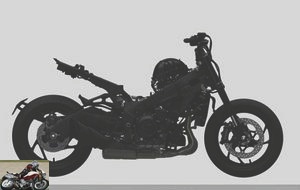 The technical basis of the Katana is the same as that of the GSX-S 1000
The technical basis of the Katana is the same as that of the GSX-S 1000
In short, Suzuki takes again this block certainly tested, but more to the very last standard. For good reason. Its specificity is to present a bore of 73.4 mm for a stroke of 59 mm, called "long" for a sports block. This characteristic, retained, gives it a rounder character, more suited to road use. The design of the camshafts has been revised to optimize this point. In addition, the manifolds are interconnected (1 and 4, 2 and 3) by balancing tubes, adjusting pressures and promoting engine responses at low and mid-speed. For better combustion, the gases are also controlled by a SET valve (Suzuki Exhaust Tuning), placed upstream of the plenum chamber. Flattened, the latter fits under the engine, allowing an ultra short exhaust silencer.
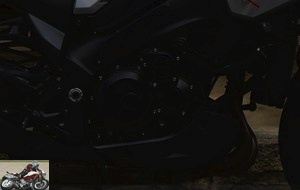 The Katana’s engine delivers 150 hp and 108 Nm
The Katana’s engine delivers 150 hp and 108 Nm
Thus prepared, the boiler delivers 150 hp at 10,000 rpm. And the four-cylinder is not lacking in strength, with 108 Nm of torque at 9,500 revolutions / min, much of which is available from the lowest revs. No Ride by WIre here, but a specific Suzuki injection system, SDTV (Suzuki Dual Throttle Valve) with double butterfly and 44 mm body (same as GSX-R1000K7) The former vary their opening according to the rotation of the throttle control . The secondary elements are controlled by the computer. They artificially reduce the passage section in order to optimize the filling of the cylinders whatever the engine speed. They each receive two long injectors, with 10 orifices. Nebulization is thus optimized, promoting efficiency and consumption, also aided by an ignition equipped with Iridium spark plugs.
Little electronic, the Katana is a desired motorcycle without artifice. No variable injection maps therefore, but the Katana also embeds an anti-slip, configurable in three modes AND disconnectable, him. Everything is controlled on the handlebars, which can be quickly adjusted while riding. This system permanently manages (every 4 milliseconds) five parameters: the speed of rotation of the front and rear wheels, the position of the throttle grip, that of the crankshaft and the gear engaged. In the event of over-rotation of the drive wheel, the engine power delivered is controlled by influencing the ignition time and the air flow.
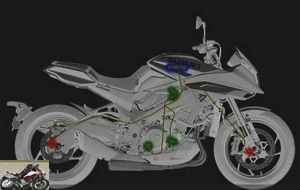 No ride-by-wire in the program, but a traction control adjustable on 3 levels
No ride-by-wire in the program, but a traction control adjustable on 3 levels
Particularly aesthetic and discreet, from the 2016 hyper-sport, the imposing aluminum swingarm is banana type. Its movements are entrusted to a Kayaba mono-shock absorber (KYB) mounted on rods. Its 63 mm stroke is adjustable in preload and rebound. On the other hand, the steering gear rests on a massive 43 mm inverted fork of the same origin and adjustable in any direction..
At the end of the sheaths, two radial-mounted one-piece Brembo calipers and four pistons each clamp 310mm discs. In contrast, a single Nissin piston clamps the rear plate. Too bad, the hoses are not in braided metal and the master cylinder is not radial…. but the Bosch ABS power unit now weighs only 640 grams.
More advantageous, we always appreciate the pretty aluminum rims with 3 curved branches and split in 17 inches. They receive a specific fit of Dunlop Sportmax Roadsport 2, in 120/70 and 190/50. Probably derived from Sportsmart, these envelopes adopt a specific design. Ribs come to dress their surface, as if traversed by saber blows ….
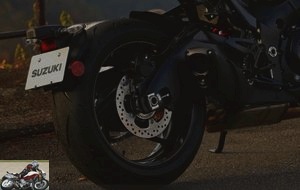 The Katana is shod in Dunlop Sportmax Roadsport 2
The Katana is shod in Dunlop Sportmax Roadsport 2
In the saddle
With 825mm of seat height, the Katana is taller than the GSX-S1000 and F roadsters (+10mm), but still accessible. Its narrowness of the saddle at the junction with the tank optimizes accessibility and the setback offered to the pilot is correct. On the other hand, the accompanying person will be less well off on his jump seat, just furnished with a simple retaining strap. Compact, the shape of the tank and its small width limit the distance between the legs. Without excess, the bending of these is still marked. The rear footrests associated with this raised seat tilt the bust slightly forward.
 The seat of the Suzuki Katana is 825 mm
The seat of the Suzuki Katana is 825 mm
Barely placed "in" the bike, the pilot is lightly supported on a right handlebar wider than that of the F roadster (+35 mm). Ideal for dynamic steering and efficient control of the steering gear. No bracelets like the original, even optional contrary to what Suzuki indicates in its presentation. At least for the moment…. ? But without regret for me, as this arrangement would increase the liveliness that we found later.
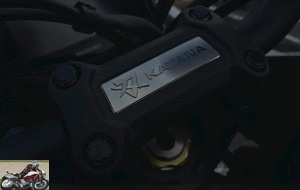 Suzuki Katana handlebar support
Suzuki Katana handlebar support
The bust tilts naturally, dropping your hands on a wide, flat handlebars, 35mm wider than that of the GSX-S1000. Sober, in its anthracite livery, the upper tee is a pretty peach from aluminum foundry with a very Japanese style and a no-frills or flawless finish. It keeps the handlebars on short saddles.
The cockpit is a reflection of the overall design, refined and qualitative. Partially sheathed, the fork shaft also hides most of the components.
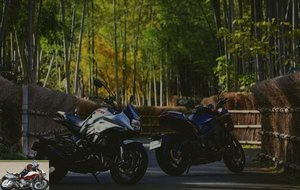 The Katana is available in two colors
The Katana is available in two colors
On the right stalk, the starter is impulse (Easy Start System). A single press is enough to start the mechanics and, henceforth, without holding on to disengage. The brake lever is adjustable in distance, but the cable clutch lever is devoid of this attention. Finally, we appreciate a large and ergonomic control, left side, managing the electronics.
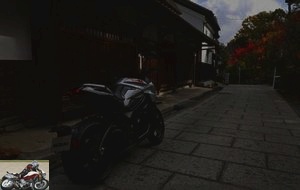 It is in the vicinity of Kyoto that we took control of the Suzuki Katana
It is in the vicinity of Kyoto that we took control of the Suzuki Katana
The functions are grouped together on a large LCD screen, with adjustable contrast, borrowed from the GSXR-1000R. The instrumentation presents a specific screen with graphics exclusively designed for the KATANA and white writing on a black background. A TFT panel would have been more rewarding and would have made it possible to create more suitable graphics and visual ergonomics. In the center, the bargraph tachometer has a “peak-hold” function (maintaining the peak value) temporarily indicating the maximum speed reached before the speed drop. The screen also includes tachometer, tachometer, odometer, 2 partial trips, stopwatch (lap time) – gear indicator engaged, water temperature, remaining range, fuel gauge, average and instantaneous consumption, clock, voltage of battery and anti-slip system mode. The latter can be adjusted or disconnected at any time from the handlebars and very quickly. A good point.
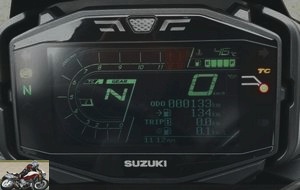 Suzuki Katana instrumentation
Suzuki Katana instrumentation
Finally, the mirrors provide a wide field and the correct turning radius allows for easy maneuvering..
In the city
In Japan, it is difficult to ride as we are used to in Europe. The density of traffic and an almost compulsive desire for safety on the part of our guests make us move on a private road, closed to traffic. The journey is short, stretched over the hillsides and mostly winding. The test is therefore special. However, we find quite noticeably on the Katana certain specificities of the 1.000 cm3 Suzuki roadsters..
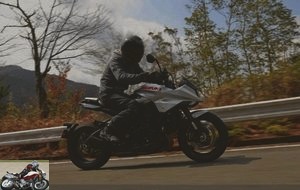 We finally get on the Katana
We finally get on the Katana
From the start, the Katana charms with the ample and serious sound of its exhaust. The athletic melody of the block is amplified by the resonance of the valve and the chamber under the machine. Discreet in aesthetics, it is much less in decibels. Suzuki has worked well on the vocalizations of his machine and the roadster barks powerfully on the throttle. Obvious to grip, the novelty is easily carried away at low speed. Its 215 kg fully loaded (one more than the GSX-S1000F) is hardly noticeable once in motion and the bike has excellent balance..
The Suzuki block made the crew take off with vigor on the intermediaries. Particularly flexible, it is soft on upper gears under 50 km / h. The selection is smooth and precise and the clutch lever is not too firm. We therefore regret once again the jerks of injection at the go-around which affects this engine at low speed. They are sensitive until third and nearly 5,000 rpm. However, the manufacturer having worked on his algorithms, this recurring fault is here much less painful than before. Narrow, the machine allows good ground support. But Hamamatsu’s athletic aesthetic is revealed at a faster pace.
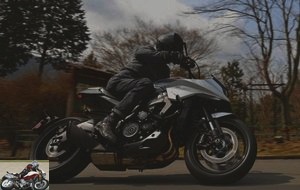 The engine is very flexible in town
The engine is very flexible in town
Motorway and expressways
The tormented layout of our Japanese test did not allow us to test the long-term dab position. By evolving well beyond the legal motorway, the lack of protection and a wide handlebars will make you a helmeted flag anyway. Because on the rare stretches, the block pushes hard although without frenzy in the towers. There are sensitive vibrations, perceptible from 6,000 rpm, ie cruising speed at the legal motorway…. Crotch, handles, footrests, the tingling then invests the machine, but then quickly disappears 1,500 turns higher. A good reason to take this powerful blade to the secondary network.
 The Katana grows hard, but the wind resistance is important
The Katana grows hard, but the wind resistance is important
Departmental
On the Isle of Man route, I appreciated the efficiency of the semi-streamlined GSXF-S1000F roadster and the expressiveness of its four-cylinder. These qualities, I find them on the handlebars of the Katana, very close to this sis with a sharp style. More elegant and attractive, the novelty is just as efficient on the road. And even more obvious to take in the Japanese ring with its significantly more engaged piloting ergonomics.
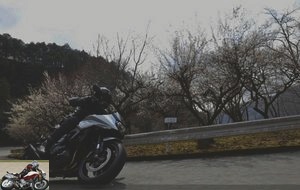 On small roads, the Katana is as efficient as the GSX-S 1000
On small roads, the Katana is as efficient as the GSX-S 1000
Full as an egg, the four-cylinder responds from 3,500 to the red zone. If its peak torque is high perched, however, it delivers most of it well before this value. The block is energetically activated after 5,000 revolutions / minute and orbiting the crew beyond 7,000, without losing strength before the breaker at 11,800 revolutions. It is also good that Suzuki has changed its throttle grip. Taking the form of a more flattened cam at the start of the rotation, the system then becomes circular again to increase the response to acceleration. This avoids being too surprised, cold tires, by a large and almost omnipresent engine power. And the traction control is also not too much, easily adjustable while driving and transparent in its implementation, but like the ABS, it is rather permissive…. watch out for commas.
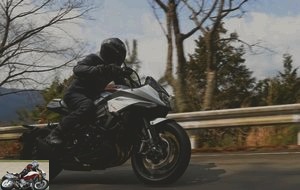 The arrival of torque is gradual and avoids being surprised, well assisted by the traction control
The arrival of torque is gradual and avoids being surprised, well assisted by the traction control
This entire character befits the Katana perfectly. On the third report or in two hairpin bends, the unit vigorously revives the machine in an almost throaty rumble of the exhaust. Hyper demonstrative, but without explosiveness, the mechanics powerfully project the crew towards the next bend. And it happens very quickly. Fortunately, the braking is up to the performance of the machine. The bite of the radial calipers is well received by the fork which plunges without excess with my 75 kilos. A bit too loose at the attack of the pads, the hydraulics then manage the stroke of the tubes with mastery. With more preload on the fork, mass transfers are effectively limited.
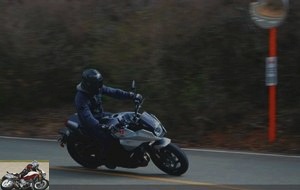 Braking is up to the power to slow the Katana
Braking is up to the power to slow the Katana
We can then attack without remorse. Especially since the Katana allows intuitive piloting. Placed more on the front on this wider handlebars, we place the machine in the eye. The Suz ‘then follows perfectly the desired trajectory on the angle. And swaying is done very naturally as the machine is stable in curves. Controlled, the injection neutral and lively, the steering gear carves out its trajectories and authorizes any possible corrections. In addition, it delivers a lot of information and generates great confidence in reading the route..
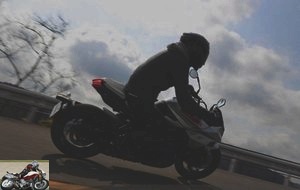 The Suzuki Katana is easy to take on a curve
The Suzuki Katana is easy to take on a curve
Aided by its Dunlop Roadsport 2 tires with an ogival profile, the Katana goes from one angle to another without downtime. Thus, the back does not "stick" as with the mediocre D214 of his sisters. In addition, these envelopes heat up quickly and their grip seems excellent, even on drying. But in mode 1, the electronics, however, allow the rear gommard to drift if one relaunches excessively.
Part-cycle
Efficient, chassis and suspensions of the Suzuki Katana give it a rare obviousness of handling and piloting. Precision and stability characterize the machine. An adjustment of the damping can optimize the behavior in evolution more sporty. I would have liked a shock absorber with separate compression / rebound settings.
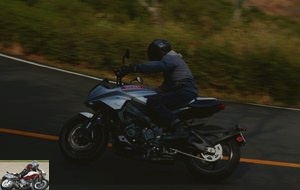 The handling of the Katana is of rare evidence
The handling of the Katana is of rare evidence
Braking
Powerful, yet progressive, Brembo radial calipers deliver an almost ideal attack. Fully modular, they provide efficient Katana decelerations. Efficient, ABS is perfectly configured. The rear device is just as usable and usefully complements the brake system, allowing the machine to be seated with precision in a curve..
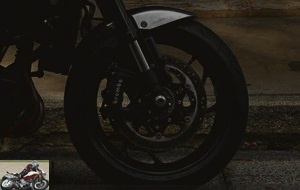 Braking has been entrusted to Brembo
Braking has been entrusted to Brembo
Comfort / Duo
The atypical driving does not allow us to judge the real comfort of the machine. It looks good to the pilot. If by any chance a geisha wanted to accompany you, she will not have grab handles (see the equipment manufacturers later?). But its wide seat is pleasant.
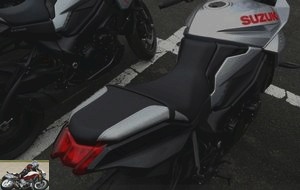 Suzuki Katana saddle
Suzuki Katana saddle
Consumption
Impossible for us to measure the thirst of the Katana. At a good pace, the GSX-S1000F averaged around 6 liters per 100 km. But it would really take a much longer test to give a certain value.
 During this test, the Katana had a fuel consumption of 6 L / 100 km
During this test, the Katana had a fuel consumption of 6 L / 100 km
Conclusion
Our too short grip of the machine will require a longer and more thorough test of certain points and confirmation of the data. Nevertheless, a real pleasure for the senses and for driving, the Suzuki Katana adds a sharp dynamic efficiency to its sleek design. Forged to cut curves and allow chiseled steering, the novelty also seems to lend itself with grace to the ceremony of urbanities. An amateur machine of expressive mechanics, the Katana is however to be taken with chopsticks for those who do not master the art of the road saber. Its hyper available mechanics require a minimum of mastery if you do not want to meet some sushi.
At little cost, the Japanese manufacturer now offers three powerful and efficient motorcycles, with attractive mechanics. The Suzuki GSX-S1000 asks for 12,699 €, the F version 13,099 € and the Katana 13,699 €. At this price, a slight increase in finishes (less visible welds) and equipment (TFT screen desired) seems possible. However, LED lights and LCD screen can partly explain this higher price..
In the neo-retro segment, Honda CB1000R at € 13,499 and Kawasaki Z900RS at € 12,299 are opponents to be feared. With its strong mechanical and aesthetic personality, the Suzuki Katana, Hamamatsu’s new saber, could well make you lose your mind..
 Suzuki Katana test in Japan
Suzuki Katana test in Japan
Strong points
- Strong aesthetics
- Engine character and availability
- Agility and efficiency of the chassis
- Sufficient electronics
- Quality of suspensions
- Precise selection
- Superb sound
- Overall dynamic efficiency
- Braking
Weak points
- Vibrations during certain driving phases
- LCD screen that can be improved in terms of ergonomics and display
- Finishing of welds
Suzuki Katana technical sheet
Test conditions
- Itinerary: winding roads with variable surface, wet and dry.
- Weather forecast: sunny, showers, 13 ° C
- Mileage: 130 km
- Problem encountered: ras
Test equipment
- Scorpion Exo-1400 Carbon Helmet
- Vanucci Tifoso jacket
- Glove Vanucci Speed Profi IV
- Jean Vanucci Armalith 2.0
Availability / Prices
- Colors: Mystic Silver, Black Night Black
- Price: 13,699 euros
- Availability: May 2019
Suzuki Katana video test
Related articles
-
Yamaha MT-07 2021 motorcycle test
Generic anti-depressant Twin CP2, 689 cm3, 73.4 hp, 67 Nm, 184 kg, 7,299 euros The face of bikers in the medium-displacement segment, the Yamaha MT-07…
-
Authentic avant-garde 4 cylinders of 999 cm3, 152 hp, 106 Nm, 214 kg full made, 19 liter tank 45 years old ! The GSX saga began in 1976 with the GS 750,…
-
Suzuki Hayabusa motorcycle test
High speed phoenix (valid for its tester after a high-side) 4 cylinders in line, 1,340 cm3, 190 hp, 150 Nm, 264 kg, Euro5, 18,499 euros Hayabusa…. this…
-
Quiet strength 4 cylinders in line of 749 cm3, 95 hp (flanged to 47.5 hp), 62.9 Nm, 213 kg full made, 8,599 euros Born GSR in 2011, the Suzuki midsize…
-
2010 Kawasaki Z1000 motorcycle test
The right machine for the bad boys ! Initiated in 1972, the Z saga is a story of heavy mechanics and strong character. After the 900 cc Z1, the first…
-
Triumph Trident 660 motorcycle test
Harpoon the competition 3 cylinders in line, 660 cm3, 81 hp and 64 Nm, 189 kg full made, 7,995 euros In the early 1960s, the Speed Twin was the British…
-
KTM 390 Adventure motorcycle test
Reverse osmosis Single cylinder, 373.2 cm3, 43.5 hp and 37 Nm, 172 kg full made, 6,699 euros For a long time the market was the queen of medium and large…
-
The Asian intruder in Power Cruisers Rather renowned for its sports machines and roadsters, Suzuki has also been offering custom models for many years….
-
197 hp at 9,500 rpm, 155 Nm at 7,200 rpm, 3 engine maps, 300 km / h, € 15,499 Cut for speed, does the myth stand up to the ravages of time? ? Thursday 11…
-
GSR reloaded Appeared in 2011, the GSR 750 hands over to the GSX-S 750, an heiress who wants to reshuffle the cards in a category in perpetual movement…
I climbed on it Sunday, impeccable driving position, with my 1m83, both feet touch the ground flat, ideal position for me, and a very nice finish, very pretty in red and white, remains to try it now, I’m sure going to miss 10 / 15ch (for the duo)
We write "saute-vent" and not "saute de vent" … otherwise, nice article, very complete, which describes very well the qualities and the faults of the newborns of Mandello.
I love !
Harley has often missed many successes other than these outdated customs.
Didn’t you want to talk about "customs with old-fashioned charm" rather than "obsolete"? Because to evoke the disuse of the mounts of the entire Hell’s Angel community around the world is to be nonchalant with one’s physical integrity.
quote: I love it !
Harley has often missed out on many success stories other than these outdated customs..
‘it’s a bit (a lot) exaggerated, you have to try a harley before giving your opinion. and by the times of speed limits of all kinds with ever-increasing surveillance and penalties, well, this kind of motorcycle with enormous sensations while remaining in regulatory speeds, and well this kind of motorcycle has, a lot of interest in continuing to have fun and not be frustrated on a motorcycle.
A guy who usually rides a sports car or a trail runner has trouble understanding what we find on this "obsolete" side, just as we have trouble understanding why we drive a Terrot or a BM R50..
Because we find the pleasure of a non-sanitized motorcycle.
I had a Honda that I had every confidence in but too perfect on its own.Try a Buell and you will come back with another idea of the Harley engine.
Unfortunately the design and development department lacks daring because he thinks that the roadster market is not for him and that his big mistake is to have let go of Erik Buell.
I have a custom "Swiss Army Knife", I change the saddle, the front fairing and I have a different motorcycle, a sissi bar and luggage and I go on vacation, stress free and at a low speed
no, I insist, d-s-u-e-t !
And much more in braking and cycle part than in engine.

I admit that it happened to me…
You should find traces of it in the Harley trials.
No kidding ?
It must be my schizophrenic side then. I will talk about it to my Motobecane, Terrot, R80 and other BSA.
At HD, the Twin Cam Screamin’Eagle 110 (stage 2) is surely their most successful engine..
Which in no way prevents global obsolescence.
Moreover, an Indian is incomparably better in every way, as well as the Royal Enfield 650. All at correct or identical prices for one, totally affordable for the other..
And to choose, an XV 1900 Midnight Star would be my custom. Yeah, a Yam ‘ !
As for finding modern production sanitized, and even if it means advising testing before speaking, a ride in Streetfighter V4, Nine T (first generation) or other KTM 690/790 should give you ideas.
In the meantime, I am looking for a 900 SS 1991, semi-faired.
You have a morale of steel?
You have the means?
Good luck.
– Well yes.
– Uh no…
– … Thank you (?)
It’s still cheaper than a 1978 SS
I like all motorcycles and adapt to their differences. I do not criticize any and any user. and does not seek to teach anyone. so I do not agree with this judgment of harleys (and other motorcycles). I would say that a motorcycle suits me or does not suit me, but I will not criticize the bike or their users.
(yet love ducati, you have to be crazy, it’s a worry nest and you need a crazy budget, I’m kidding !!) like what, all tastes …
criticizing a brand is a bit like people who go to Italy and find Italy dirty !! they missed all that is beautiful in Italy (and there is something to admire) to see only the dirt.
faults are also part of the charm.
Speaking of obsolete, BMW fans will appreciate the new R80.
But why BMW bothered to release such a bike, oh yes for the custom market, what an idea. Because in the backward-looking side, everything is there, and yet I find it very successful.
BM did not always shine for its sense of aesthetics.
Everything is a question of global perception, I don’t like the Indians, I find them heavy except the FTR 1200 and I prefer the Triumph to the RE, which does not prevent me from finding them nice.
What’s tiring is that guys who don’t like Harleys spend all their time wanting to knock them out when we don’t give a damn. It has become almost a game, if we choose a motorbike it is suitable for us, although at my age I only have to do performance, I find pleasure in it and what matters to me the rest
Did the words escape you?
The words escaped you?
Rhooooo…!
I would like one in my garage. Super stylish this machine.
Next to a RSV4 1100 Factory…